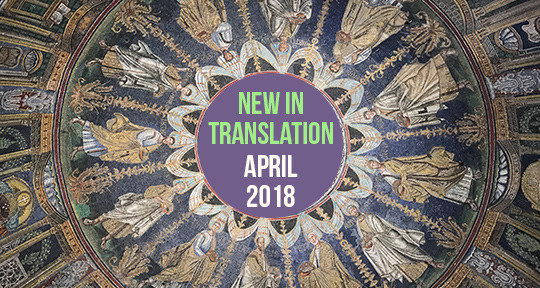It’s spring, the days are (hopefully) sunny, and this month we’re back to shine a light on some of the most exciting books to come in April, including works in translation spanning Colombia, Lithuania, Martinique, and Spain (Catalonia).
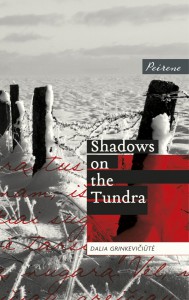
Shadows on the Tundra by Dalia Grinkevičiūtė, translated from the Lithuanian by Delija Valiukenas, Peirene Press
Reviewed by Josefina Massot, Assistant Editor
In his Afterword to Shadows on the Tundra, Lithuanian writer Tomas Venclova draws a parallel by way of praise: Dalia Grinkevičiūtė’s account of the Gulag ranks with Alexander Solzhenitsyn’s and Varlam Shalamov’s. Those acquainted with Gulag survivor literature know that’s high praise indeed: Solzhenitsyn’s The Gulag Archipelago and Shalamov’s Kolyma Tales are paragons of the genre. And yet, I venture, Shadows on the Tundra transcends them both.
It isn’t by virtue of its content, although it’s tempting to assume so. After all, Solzhenitsyn and Shalamov were Russian intellectuals imprisoned for alleged political dissent, while Dalia (one can’t call her by her last name after reading her, etiquette be damned) was a Lithuanian girl with no political affiliations. Surely, one thinks, the way in which they were (mis)treated by the Stalinist regime varied accordingly. When it came to torture, however, Soviet communism seems to have made good on its otherwise forsaken promise of equality: Dalia was also plucked from her home and taken to a far corner of the Soviet Union; she, too, lived in crammed, filthy, poorly insulated barracks; she was equally subjected to the wrath of the guards and the elements; she was worked to near death while fellow inmates died of cold, hunger, and disease.
What sets Shadows on the Tundra apart, then, is not so much the what but the how—the singular way in which it tells a shared story. Solzhenitsyn’s prose is passionate but, in the words of Slavist Geoffrey Hosking, also “fiercely moralistic”; Shalamov’s is “studiedly dry and neutral,” which effectively contrasts with the content at hand but runs the risk of seeming aloof. Dalia’s strikes a welcome balance between both: it boasts passion without sanctimony, plainness without detachment.
The author describes her circumstances tersely, rarely bemoaning or trying to make sense of them. Particularly striking, for instance, is her depiction of how a dead child is thrown off a chopping board and under a bunk in the overcrowded barracks because there’s nowhere else to put it; after recounting the scene in the barest possible terms, she moves on without giving it a second thought. While it may seem removed, her approach to this and other horrors reveals a nuanced sense of their ineffability: since they escape human reason, attempts to unpack them will only undermine them; they speak loudest when they speak for themselves. Dalia, in fact, is anything but cold. She’s often angry, sometimes vulnerable, and, above all, stubbornly optimistic: she’ll take pleasure in her daily ration of bread, laugh in the midst of a treacherous blizzard, and stop to “admire the splendour of the mighty and ruthless Arctic.” There are shadows on the tundra, to be sure, but she revels in whatever light seeps through.
Her fresh voice sprouts, in part, from demographic chance—she was taken at fourteen—and, in part, from editorial choice: Peirene has translated the diaries she penned between 1949 and 1950 (when she was in her early twenties), covering her ordeals up to 1942/43 (when she was sixteen at most). As opposed to the more comprehensive ones she wrote decades later, these constitute a girl’s rendering of a girl’s life—youth’s bluntness and sentiment thus doubly preserved.
At times, though, Dalia seems much wiser than her years. Nowhere is this clearer than in her portrayal of her countrymen, one of the memoir’s focal points (its original title translates as Lithuanians by the Laptev Sea). While supervisors treat them like “cattle,” she strives to preserve their humanity through detailed, often humorous depictions of their ways (Krikštanis “can’t seem to live without an audience”; Vorobyova and Yudina are so ragged that “Gorky’s ‘barefoot’ poor look like English lords by comparison,” etc). To humanize, however, is not to glorify, and Dalia knows it: she also writes of their corruption under duress. Many start to steal food from their children or spouses; one of them joins the officers to save his neck; others mock an inmate as he’s dying, and so on. “All pretense,” she states towards the end, “all those empty civilities and urban refinements with which we arrived, have dropped from us like borrowed rags.” She later adds: “We have been brutalized.”
The term is loaded: it means they’ve been treated brutally, yes, but also turned into brutes—thrown into a Hobbesian nightmare by the very powers that should have kept them from it. This, which might seem like an indictment of the victims, is in fact the greatest possible charge against their oppressors: worse than stripping someone of their freedom—their life, even—is to strip them of their decency. That Dalia can pose such an awkward moral issue speaks to her courage; that she can do so without moralism—by showing rather than telling—betrays her literary chops.
Editor’s Note: While this book is not available until June, we share this review with you today to join the London Book Fair in celebrating the Baltic Countries. The review is made possible by the Lithuanian Culture Institute.
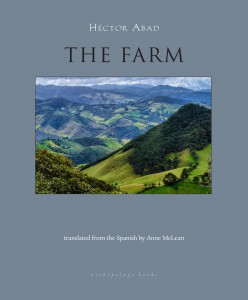
The Farm by Héctor Abad, translated from the Spanish by Anne McLean, Archipelago Books
Reviewed by Catherine Belshaw, Grant Writer
Héctor Abad’s The Farm is not the book it at first appears to be.
A meditation on history and family in Colombia, The Farm recounts the story of the Ángel family from the perspectives of three of its members, Pilar, Eva, and Antonio, as they contemplate the past, present, and future of La Oculta, the remote family farm that serves as homestead and countryside retreat, dream and nightmare, for generations of their family.
But The Farm is also so much more.
Written from the perspective of the three siblings, each chapter reconstructs a particular and unique history of the town and region in Colombia where the farm is hidden, as well as that of the farm itself, and the family that built and is now struggling to maintain it. Each of their voices circles around the events that define the family, what Pilar calls “the things that have happened, the things that still happen on this farm. First those who’ve drowned in the lake (five, as far as I know)… Lucas getting kidnapped… The time when they came here to kill Eva. Deaths of previous Ángels.”
Considering the structure of the book, one wonders whether it is meant to provide a kaleidoscopic view of this world through our three narrators with La Oculta as their muse or if Abad’s real interest is in exploring something much deeper. Reading through the first chapters, I couldn’t help feeling that there was another story that Abad could have told about the Ángels, La Oculta, and Colombia if The Farm had been written with a different structure: from the perspective of an omniscient narrator, or from just one of these characters, each of whose voices could, on their own, have easily carried the whole novel. But the more I read, the more deeply and quite personally, I began to appreciate the characters for who they were, characters whose voices Abad so carefully prepared and translator, Anne McLean, clearly took great pains to preserve.
Pilar, the calm voice of tradition, is steadfast and faithful, practical and present. Antonio is the voice of history but is also the most physically distant from the farm and the family, and so also the most nostalgic. While Eva’s is the voice of personal and interpersonal struggle. She abides as burdened free spirit, constantly seeking escape from all that both Antonio and Pilar represent. These perspectives reveal themselves in their musings on La Oculta.
Antonio writes:
Giving up a farm like La Oculta is like giving up someone we once believed was the love of our lives. What was the farm? A small fulfilled promise of what America was said to be and mostly was not: a place where you can get a piece of land if you work hard. What was love? Something you were going to receive forever, if you always gave it; somewhere you went to sow, to reap, and to die. Pilar still trusted those dreams…
While Eva says:
I love and I hate the countryside. But maybe La Oculta might not be exactly the countryside, but rather something else. La Oculta is the deepest and most obscure part of our origin, the black, smelly, fertilizer that everyone in our family grew out of.
And Pilar:
They tell me I’m the most antiquated of the siblings, but let’s just see, deep down I’m the most modern, the one who doesn’t look to the past, like Toño, or to the non-existent future, which is over for us or ending, like Eva. I’m the one who lives in the present, here and now, in these few moments of life left to us, and its best to live them without crying, in a beautiful, bright, new house, in a house rebuilt with goodwill.
Does this approach help Abad tell his story about Colombia? In his celebrated memoir, Oblivion, Abad depicts his Colombia as brimming with love and tainted by violence, and as a place for which he feels both nostalgia and despair. The reader may find that this very personal approach to telling the story of The Farm is indeed a powerful way to further explore these themes. Abad can explore History/history/myth, the passage of time (past/present/future), sexuality/love/marriage, ambition/need/desire, the interplay of individual/family/community, through the voices of each sibling whose unique explorations will move different readers in different ways. As the personal and family histories build and intertwine, each narrators’ words nourish and thrive off the others. Each of us will find something personal or familiar or profound to identify with in one of the three characters, an exercise I found most enjoyable as I considered and internalized the spirit of each one. It is essential that we hear and understand these competing narratives to understand the meaning of The Farm.
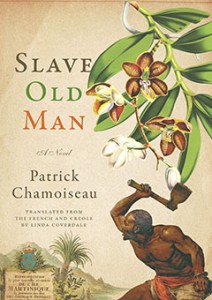
Slave Old Man by Patrick Chamoiseau, translated from the French and Creole by Linda Coverdale, The New Press
Reviewed by Diána Vonnák, Editor-at-Large for Hungary
A slave old man leaves a sugar plantation. For a long time he has been watching the Master’s violent mastiff, shipped from Europe in order to catch marooners and nurture fear among the workers; they are mortal enemies. Yet it is their kinship that weighs on the old man, stirring up a once-dormant, inner chaos: “[h]e rediscovers in the mastiff the catastrophe inhabiting him. A gimlet-eyed fury that lashes out from afar” (31). The dog, shipped there against its will, lives as an extension of the Master—a mere instrument locked in wordless semi-comprehension and a shaky sense of time. In the toxic power dynamic of the plantation, slave and dog are doppelgängers: the absurd juxtaposition of their inner worlds serves to highlight the sameness of oppression on their minds. They are bound together by their shared subordination, this theft of the room one needs to house an identity.
Martinican author Patrick Chamoiseau is not new to English-speaking readers: his Prix Goncourt-winning novel Texaco and his Creole Folktales are among the most important works of the créolité movement and French post-colonial literature. In Slave Old Man, Chamoiseau continues to explore similar themes: oppression, resistance, subversive narratives, collective resources maintained by rituals, storytellers and dancers. “Marie-Sophie, my lump of barely sugar, in Creole we know how to say slavery, or the chains or the whip, but none of our words and riddles can say Abolition” (100), Texaco’s protagonist remarks to herself, highlighting one of Chamoiseau’s key concerns with language.
Chamoiseau’s texts are linguistic interventions: their heavily Creolised, rhythmic prose, their narratives—so heavily indebted to Caribbean oral history—are at once literary feats and statements of cultural political protest. It is not difficult to see the continuous relevance of this gesture in the wake of French president Emmanuel Macron’s recent pledge to reinvigorate the status of the French language in the “Francophonie.” Chamoiseau is among the “authors who write with an accent,” as Congolese author Alain Mabanckou claimed them in a recent interview. Chamoiseau achieves this with a densely lyrical language that at places evokes Márquez or Rushdie, but goes much further in its transgression: conventional distinctions between human and non-human, nature and culture cease to matter in his prose. There are long scenes where bodies and machines merge: “His skin takes on the texture of the cast-iron buckets or rusty pipes” and the Master cannot tell them apart anymore. Later it is the forest he blends into: “He stays still as mangrove-water” (57). The text is laden with similes, metaphors, and Creole is scattered among the translated English. Linda Coverdale does an impeccable, sensitive job in preserving the strangeness and incomprehension of the Creole words and phrases, while allowing the text to flow. Her Afterword also adeptly places Slave Old Man within its biographical and intellectual context.
Coverdale observes that Slave Old Man could be seen as the practice for a theory Chamoiseau laid out in the same year in his “Writing in a Dominated Land” (129). That theoretical ideas inform and undergird his works of fiction remains obvious throughout the text. It is an incredible undertaking to enter a world maimed by an absence of tools of self-expression; writing around silence occasionally risks didacticism. It seems that the narrative falls short of the language, that there is little room for the old man or others to be distinct individuals. Chamoiseau tries to dissect what oppression does to the self, the loss it brings, credibly evoking oppression in its universality as it mutilates voices, emotions, selves. At the same time, he shows the subversive creativity of the oppressed, upholds resistance and the richness of Martinican Créolité. These two political projects are within crosshairs here and it is difficult to see the face of the old man, his personality. Resistance and disobedience have to remain in focus, leaving little room for anything else. Nevertheless, the novel is poignant, timely, and radical—even if it occasionally becomes a hostage of this mission.
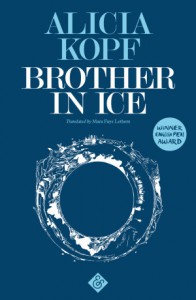
Brother in Ice by Alicia Kopf, translated from the Catalan by Mara Faye Lethem, And Other Stories
Reviewed by Norman Erikson, Editor-at-Large Indonesia
Written in a hybrid form that mixes fiction and nonfiction (and the pseudo versions of both), Brother in Ice stitches the author’s fictional memory with the history of polar exploration. Its narration is anything but linear, using a montage of text, photos, and sketches.
Using the first-person perspective, the narrator tells us about her coming of age along with the separation of her parents and the life of her autistic brother. She depicts her brother as a “man trapped in ice,” who has fissures inside him that periodically freeze over: always there physically, but sometimes not there. The novel speaks about how her brother’s dependence affects her life and how it exposes the humanity of people around him. It also explores a the idea of a “frozen” romantic relationship in a contemporary world full of social media and dating apps.
Those personal stories intertwine with the heroic tales of polar explorers like Frederick Cook, John Cleves Symmes, John Barrow, Robert Peary, etc. This forms a duality that works as two mirrors facing each other, intensifying and illuminating each other through juxtaposition.
Throughout the novel, we encounter observations of the human condition through ice-based metaphors. I love how the narrator carefully picks a fact and turns it into a rumination. One of my favorites is when she makes a comparison between ice and photography, how death by ice retains the body’s shape the way images do.
The obsession of ice itself comes from the belief that coldness brings peace, and how we have long sought consolation in icy places. It’s a metaphor for healing, but also of self-exile. In the first chapter, we are presented with a story of Frederick Cook who underwent a journey to the North Pole after the death of his first wife and their baby during labor. In much the same way, this novel seems like the narrator’s “polar exploration,” as hinted in the sub-chapter “Berglust” (which translates as “the lust for mountains”):
Ice shrinks the veins and capillaries that bring blood to an injured area… ice calms the pain of knocks, but if you ice a wound too long, the result can be detrimental… The insensitivity can damage the healthy skin around the wound. I need to finish this project soon…
In this novel, ice is a way to explore ideas of the past, of memories, of stagnancy, of the death of intimacy.
This also speaks to the relationship artists have with their art, how sometimes we use art to channel our trauma but the act of creation itself also relives the already blurred memories. The comforter is also the torturer. As a consequence, the narrator of this novel also feels the need to scrutinize her idea of fiction, challenging its convention.
“Third-person narrations are security fences,” writes the narrator near the end of the book, commenting on the writing of this book. “Omniscient narrators, pure arrogance,” she continues. In addition, she is also very open with the fragility of her fiction. She hates objectivity and admits that narration is a way to fictionalize memory. In this way, the book is very subversive.
*****
Read more recent reviews from the Asymptote blog:

